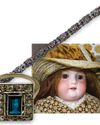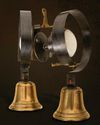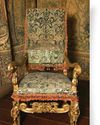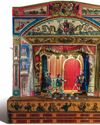
Fortnum & Mason's association with the monarchy is nestled somewhere in the subconscious - it's an intrinsic part of the company's history that has helped to establish its reputation as a luxury brand. The relationship goes right back to the company's foundation over 300 years ago, when William Fortnum was a footman at the court of Queen Anne. One of the perks of Fortnum's job was to empty the half-burned candlesticks and take the leftover wax home, where he remelted them and resold them to ladies of the court. Hugh Mason, meanwhile, had already started up his small grocery store in Duke St, St James's Market, when he met William Fortnum and became his landlord. With William's palace connections, Mason found himself in an excellent position to sell commodities to the gentry and aristocracy and, by 1707, Fortnum & Mason had been established.
In 1840, William's great-grandson, Richard Fortnum, ploughed the company's profits into the new building at 181 Piccadilly, where the shop stands today. With its elegant fanlights and decoration, the designers of the building were deliberately inviting women customers inside to look at the wares on show,' says Dr Andrea Tanner, Fortnum & Mason's archivist. Its innovative use of plate glass windows - only invented three years earlier - further encouraged customers to experience the wonders within and became an important part of Fortnum's advertising strategy, especially at Christmas. During the 1860s, displays included a live turtle in a tank (to show that the turtle soup was made from real turtles!) and a rose-tinged honey, backlit by the windows, that was specially produced using a method that didn't kill the bees. 'It's an interesting building,'adds Andrea. It looks old-fashioned but is very modern; a theme of Fortnum & Mason.'
Diese Geschichte stammt aus der June 2022-Ausgabe von Homes & Antiques.
Starten Sie Ihre 7-tägige kostenlose Testversion von Magzter GOLD, um auf Tausende kuratierte Premium-Storys sowie über 8.000 Zeitschriften und Zeitungen zuzugreifen.
Bereits Abonnent ? Anmelden
Diese Geschichte stammt aus der June 2022-Ausgabe von Homes & Antiques.
Starten Sie Ihre 7-tägige kostenlose Testversion von Magzter GOLD, um auf Tausende kuratierte Premium-Storys sowie über 8.000 Zeitschriften und Zeitungen zuzugreifen.
Bereits Abonnent? Anmelden

Lisa Coppin
The Cotswold Company’s chief creative officer shares the pieces that mean so much to her

TRAVEL
Six of the best pineta, plus a festive trip to Covent Garden. Review of The Orange, Belgravia by Katie Pike, travel stories

OLD SHEFFIELD PLATE
Stumbled upon by chance, this ingenious material was a more affordable option than solid silver, and well-preserved examples are particularly desirable today

Merrily on high
Summoning servants since the 1700s, bell boards create instant English country-house style (even if you don't have any servants). Emma Longstaff dons her pinny

Let it snow
Nostalgic, magical and highly collectable, snow globes are curious objects of wonder that never fail to instil joy

Velvet Crush
Once the preserve of the wealthy, velvet finally touched all levels of society, thanks to advances in its production process

Celebrating in the Stable
Antiques dealer Julia von Hülsen specialises in Gustavian pieces - all of which look perfectly placed in her German home

THE SHOW MUST GO ON
Victorian toy theatres charming and exquisitely designed miniature worlds have inspired theatre royalty for decades. Today, the tradition is being kept alive by a small but talented network of makers

NICHOLAS LEES
The ceramic artist talks to Dominique Corlett about new ways of working with clay and blurring the edges of solid objects

Candy CHRISTMAS
Pastel hues, vintage decorations and bowls of sweet treats: the festive run-up is gloriously joyful at Bettina Færgeman's historic Copenhagen apartment, where there's an emphasis on entertaining...